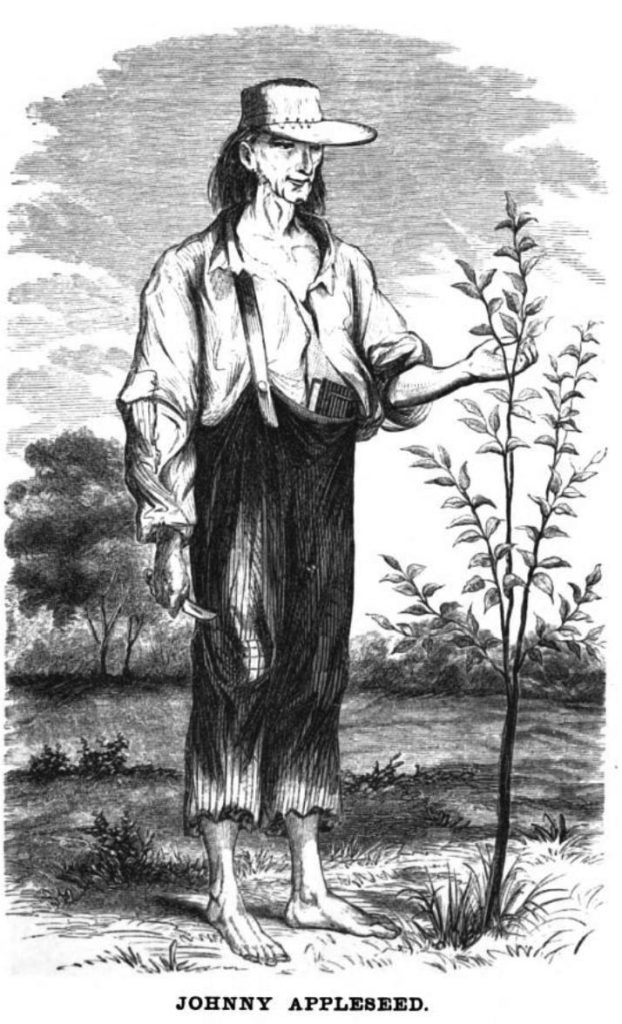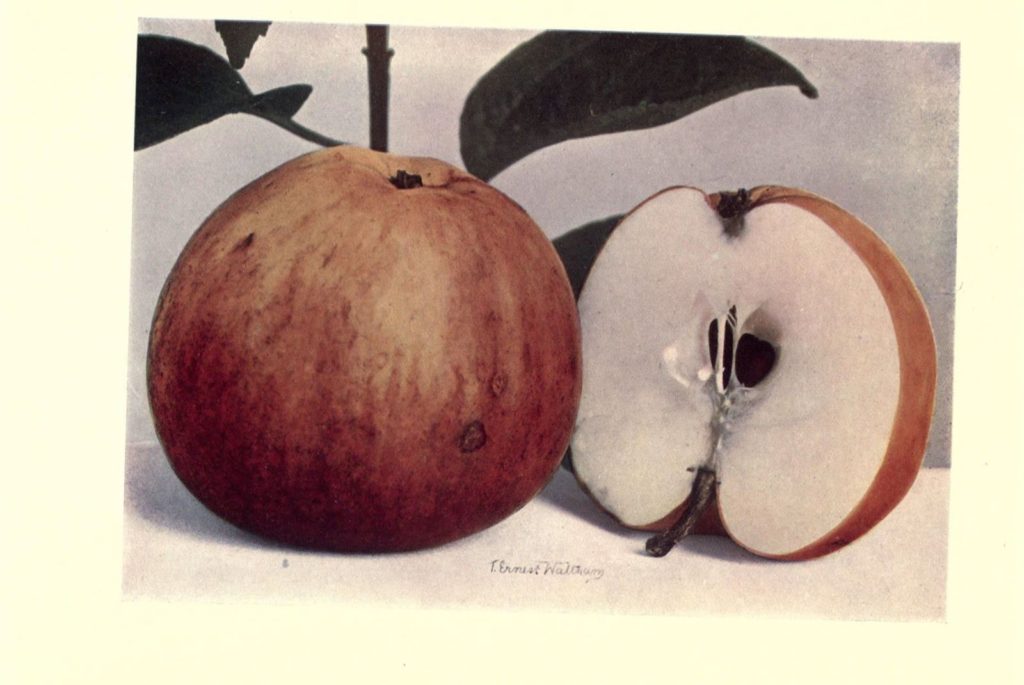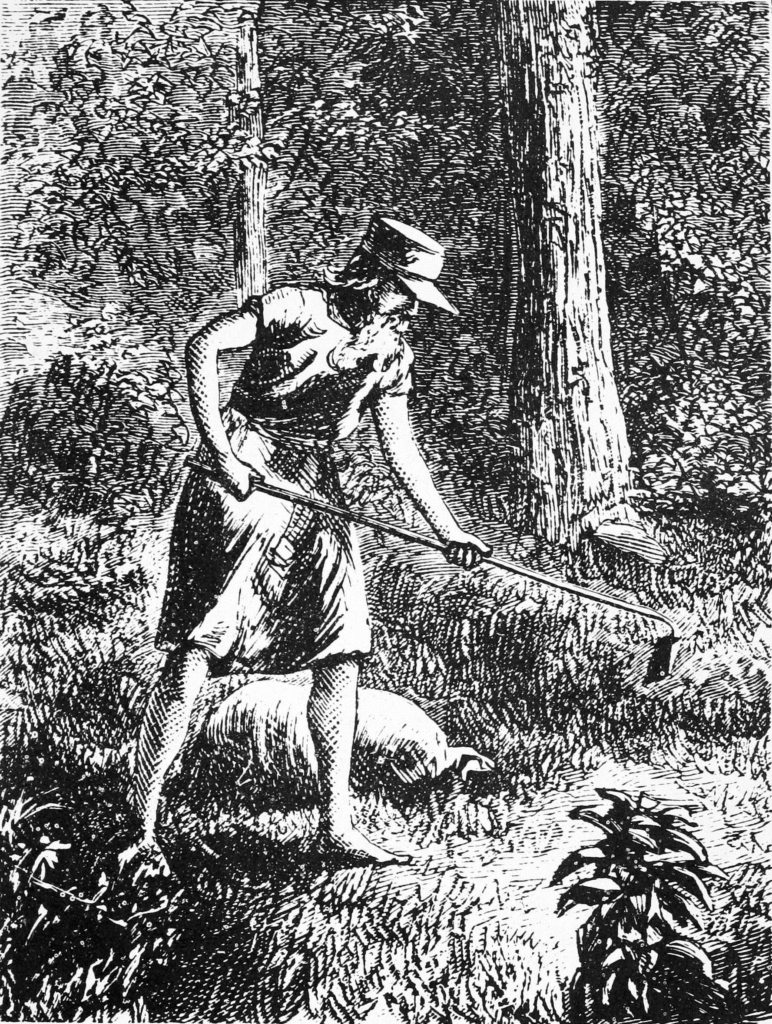So you don’t believe in Paul Bunyan or Sasquatch, here’s one you can believe in: Johnny Appleseed was a real man who roamed around planting apple trees. And many consider him one of our earliest and most ardent conservationists. But, there is a bit more to the story than just that.

John Chapman, who would become known during his life and for all time as Johnny Appleseed, was born on September 26, 1774, near Boston, Massachusetts (died 1845). When he was 18, he left home to venture into the wilderness—which, at the time, was Pennsylvania, Ohio and Indiana. He never took up a homestead, rather sleeping outdoors or in the barns of friendly farmers he met along his journeys. He eventually began working as an orchardist, learning the trade that we would today call horticulture.
The myth suggests that Chapman wandered haphazardly, planting applet trees at random, rather like a distracted flower girl dropping petals at a wedding. In fact, he worked from an ingenious strategy. In the early 1800s, the federal government was beginning to give grants of land to settlers who would tame the forests of the upper Midwest into cultivated land. In order to gain title to the land, however, settlers had to prove their intention to remain there by planting 50 apple trees in three years—a sign of investment in the future.

Chapman recognized that meeting this requirement would depend on a source of trees. So, he set out ahead of the wave of settlers and planted apple-tree nurseries at what he thought were likely spots for settlement. A few years later, when settlers arrived, he sold them the trees they needed from his orchard. He did this over and over, mostly in Ohio and then Indiana, enjoying a steady stream of income that made him a wealthy man. When he died, he purportedly owned 1200 acres of apple orchards across the region.
He didn’t need all that money, however, because he was a devout Christian who purposely lived a life of poverty. He never had a home, wore no shoes and the simplest of clothes (his favorite garment was an old seeds sack with holes cut for his head and arms), and ate no meat or animal products. When a farmer couldn’t afford to buy his trees, he gave them away with a promise from the farmer to pay him in the future. He also served as a missionary, teaching his brand of religion to everyone he met.

Chapman, apparently for religious reasons, also believed that trees should be grown from seeds, not grafting. So, he gathered apple seeds from cider mills in Pennsylvania and hauled them westward to create his orchards. Unfortunately, apple trees grown this way produce nasty little sour apples, inedible as raw fruit. But, they made great cider—hard cider—that settlers used as their household drink because the available water was usually unhealthy. So, Johnny Appleseed supplied not big juicy eating apples, but the raw materials for making alcohol. Good old Johnny.
So, where does the conservation come in? According to the journal American Forests, “Chapman was a successful businessman, but he was also a conservationist and a true outdoorsman.” National Geographic called him “an icon of the conservation movement” and another source named him an early ecologist. Primarily, that praise comes from his planting of trees. Planting trees is a true conservation activity, given that trees do so much for us, from providing apples, even sour ones, to absorbing greenhouse gases.
But his biggest claim as a conservationist, I think, comes from his dedication to preserving biodiversity. He believed in the fundamental value of all living things, no matter if they were obviously useful or not. He loved insects and, as they say, wouldn’t hurt a fly. In fact, one night while watching insects become attracted to his fire and dying in the flames, he doused the fire and slept in the cold to avoid harming any more. Once bitten by a rattlesnake, he reacted violently and killed the snake; for the rest of his life, he despaired of his intemperate action: “Poor fellow, he only just touched me, when I, in the heat of my ungodly passion, put the heel of my scythe in him and went away.” When he saw domestic animals, especially horses, being mistreated, he bought the animals and then paid a local agent to nourish them back to health. He understood the values of many wild plants, a trait that earned him respect among Native American tribes he visited.
And for your next trivia contest, here’s one for you. Yes, Johnny Appleseed did wear a tin pot for a hat. He didn’t see any reason to own two things—a pot and a hat—when one could do both jobs just fine.
References:
American Forests. 2014. From businessman to folk legend: Johnny Appleseed. Loose Leaf, September 26, 2014. Available at: https://www.americanforests.org/blog/from-businessman-to-folk-legend-johnny-appleseed/. Accessed July 6, 2019.
Birkhimer, Lily. 2012. Johnny Appleseed: Folk Hero. Ohio Memory, September 28, 2012. Available at: https://ohiohistoryhost.org/ohiomemory/archives/849. Accessed July 6, 2019.
Kettler, Sara. 2015. 7 Facts on Johnny Appleseed. Biography, Mar 10, 2105. Available at: https://www.biography.com/news/johnny-appleseed-story-facts. Accessed July 6, 2019.
National Geographic. Sep 26, 1774 CE: Happy Birthday, Johnny Appleseed. National Geographic Resource Library. Available at: https://www.nationalgeographic.org/thisday/sep26/happy-birthday-johnny-appleseed/. Accessed July 6, 2019.
